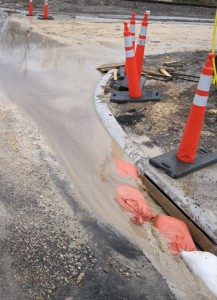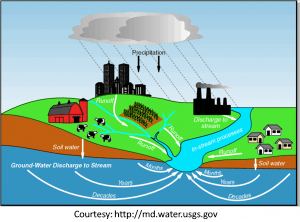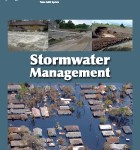 Stormwater is any water running off a land surface before it reaches a natural water body. It occurs when the rate of precipitation is greater than it can infiltrate, or soak, into the soil. Runoff also occurs when the soil is saturated. Runoff remains on the surface and flows into streams, rivers, and eventually large bodies such as lakes or the ocean.
Stormwater is any water running off a land surface before it reaches a natural water body. It occurs when the rate of precipitation is greater than it can infiltrate, or soak, into the soil. Runoff also occurs when the soil is saturated. Runoff remains on the surface and flows into streams, rivers, and eventually large bodies such as lakes or the ocean.
Movement of this stormwater across the soil causes erosion. It can also carry and deposit untreated pollutants, such as sediment, nutrients and pesticides, into surface-water bodies (as seen on the left).
Impervious surfaces such as driveways, sidewalks, and streets block rainfall and other precipitation from infiltrating naturally into the ground, leading to even more stormwater and potential pollutant runoff.
Rainwater harvesting offers a small-scale best management practice to reduce stormwater runoff and the problems associated with it. By harvesting the rainfall and storing it, you can slowly release the water back into the soil, either through irrigation or direct application. The water then moves into groundwater table, providing a steady supply of water to local streams and rivers. *See image below.
Related Resources
Rain Gardens One method of stormwater control that also adds an aesthetic benefit to your landscape is the rain garden. Please follow this link to go the rain garden page.
 Stormwater Management Pollutants in stormwater discharges remain a significant source of environmental impacts to water quality. The Clean Water Act regulates certain discharges of stormwater. Learn which sources are regulated and what can be done to control stormwater.
Stormwater Management Pollutants in stormwater discharges remain a significant source of environmental impacts to water quality. The Clean Water Act regulates certain discharges of stormwater. Learn which sources are regulated and what can be done to control stormwater.
 Rainwater Harvesting: Soil Storage and Infiltration System A soil storage and infiltration system collects rainfall runoff from the roofs of buildings and directs it underground where it infiltrates the soil. Such a system conserves water and protects it from surface pollution.
Rainwater Harvesting: Soil Storage and Infiltration System A soil storage and infiltration system collects rainfall runoff from the roofs of buildings and directs it underground where it infiltrates the soil. Such a system conserves water and protects it from surface pollution.


Pingback: If El Niño is coming – Lets Talk Stormwater Management | RecycledH2O
Pingback: Rainwater Management Can Help Increase Water Efficiency – Laura Varela Fallas
Pingback: 10 viviendas de bajo costo en la India - RTF | Rethinking The Future
Pingback: How Much Rain is L.A. Capturing? - Pioneer News Limited
Pingback: How Much Rain is LA Capturing? Legal Planet - News Fall Out
Pingback: Eco-Friendly Land Clearing Techniques For Developing Commercial Properties